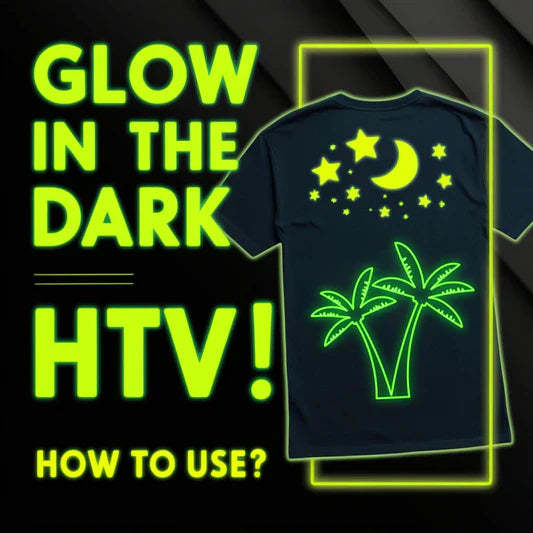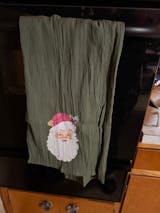Really great product! I love how teckwrap uses the top protective film because the highly reflective style of holographic films are very easy to scratch during transport or storage!!

Best Fabric For Heat Transfer Vinyl : Garment Printing 101
Posted By TeckWrap Craft On february 29, 2024

Table Of Contents
Heat transfer vinyl (HTV) or iron-on vinyl is a special type of material used to print on garments and different fabrics. But what is the best fabric for heat transfer vinyl? HTV adheres well to cotton, polyester fabric, poly/cotton blends, canvas, and denim.
In this crafting guide, you’ll learn about applying heat transfer vinyl designs on fabrics, the supplies needed, the proper temperature, and everything you need to know about heat transfer printing using HTV. Remember, when designing with heat transfer vinyl, the right combination of temperature, time, and pressure matters.
What temperature, time, and pressure you should set on your heat press machine depends on the type of fabric and vinyl you plan to use. To give you an idea, here are the heat transfer vinyl products available at TeckWrap Craft and the proper temperature and time required when printing.
| TeckWrap Craft Heat Transfer Vinyl | Heat Press Temperature (in ℉) | Time (in seconds) |
| Colorful Camouflage Heat Transfer | 300-315 ℉ | 10-15 |
| Flock Heat Transfer Vinyl | 300-315 ℉ | 10-15 |
| PU Heat Transfer Vinyl | 300-315 ℉ | 10-15 |
| PU Rainbow Stripes Heat Transfer Vinyl | 266-284 ℉ | 8-12 |
| Glitter Heat Transfer Vinyl | 300-315 ℉ | 10-15 |
| Colorful Splash Heat Transfer Vinyl | 300-315 ℉ | 10-15 |
| Galaxy Heat Transfer Vinyl | 266-284 ℉ | 8-12 |
| Glow In The Dark Heat Transfer Vinyl | 300-320℉ | 8-12 |
| Snowflakes Pattern Heat Transfer Vinyl | 300-315 ℉ | 10-15 |

Supplies Needed For Heat Transfer Printing Using HTV
- Fabric of your choice
- HTV of your choice
- Heat press machine (EasyPress, Cap press or Logo Press)
- Weeding tool
- Parchment paper or thin teflon sheet
- A lower heated element like a rubber pad (usually comes with the heat press machine).
- Cutting machine (Cricut or Silhouette)
Best Types Of Fabric For Heat Transfer Vinyl Printing
If you want to enter the apparel industry or start your clothing line, you should know the best fabrics for heat transfer printing using vinyl. Here at TeckWrap Craft, we have gathered the best types of fabrics on which you can print heat transfer vinyl designs.

Ring-Spun Cotton Fabrics
The easiest and most common printable fabric is cotton. 100% cotton shirts require high-temperature settings for the HTV to adhere properly. In the photo seen above, PU HTV from TeckWrap Craft was used for the shirt.
Don’t confuse yourself with the tumbler. Permanent adhesive vinyl was used for that. Is there a recommended brand of shirts? It doesn’t matter what brand of T-shirt you are using as long as it’s made of 100% cotton.
Other than ring-spun cotton shirts, you can also print on other materials made of cotton like aprons, bedroom slippers, or pillowcases. However, you have to be careful to use the right settings. Do not use high heat for the bedroom slippers above as their cotton fabric is thinner than the one used for the usual cotton t-shirt. A high temperature may cause scorch marks.

Polyester Shirts
Polyester T-shirts, most commonly used for sportswear, can also be designed with heat transfer vinyl. Polyester is a more delicate fabric and can get scorch marks easily, hence, it requires low temperature and medium pressure.
It is recommended to use regular heat transfer vinyl with it. As with cotton t-shirts, you cannot use specialty vinyl on it. Polyester is the best fabric for block sublimation migration or sublimation printing. It is also called sublimated fabric.

Denim
May it be a jacket or jeans, yes you can apply HTV on denim. However, the challenge with it is that it does not have a smooth and flat surface. Heat transfer vinyl works best on a fabric with a flat or smooth surface.

Canvas
Yes! You can print vinyl on canvas fabrics too! May it be a canvas tote bag, wallet, apron, or pillowcase. How much heat you need depends on the type of vinyl you use, so make sure to check out the guide above.

Hoodies And Sweatshirts
Heat transfer vinyl designs are also applied to hoodies and sweaters. Most of these apparel are made of 100% cotton or ring-spun cotton with significantly fewer stray fibers and a tight weave, thus applying HTV with high heat application settings will be successful.

Hats
Yes! You can print heat transfer vinyl on baseball caps or bucket hats too. However, the biggest challenge when it comes to these types of merchandise is their not having a flat surface. That’s why a flatbed heat press machine won’t work for this type of printing.
A mini EasyPress or cap heat press is recommended to transfer print on this apparel. Caps are made of different types of materials like cotton, nylon, or polyester. If the hat is made of linen, be extra careful as it’s one of the most heat-sensitive materials.

Mittens
Oven mittens are usually made of polyester and cotton, both compatible with heat transfer vinyl printing. When printing on an oven mitten, one thing to remember is to use hard pressure since the fabric is thick.

Tips When Printing On HTV Fabrics
- Use parchment paper or a Teflon sheet to avoid scorch marks on the fabrics or heat press boxes.
- Use a lower heat press platen for fabrics with uneven surfaces like denim. The lower heat press platen is placed under the garment.
- If the HTV is not sticking properly on the garment, try to repress it again.
- When peeling the carrier sheet, always check if the HTV is a cold peel or hot peel (check the product instructions of the vinyl).
- Always pre-press the garment before printing the design. Do it for 5 to 10 seconds to wick away moisture.
- When applying HTV, use the right time and pressure.
- Do not forget to mirror the design or flip it horizontally on the software before sending it for cutting.
- It is recommended to use a heat press rather than iron on it.
- For HTV, the shiny side is the carrier sheet. The dull side is what faces the blade on the cutting machine.
- Fabrics made of cotton blended with other materials like polyester are also compatible with HTV printing.
- Always stick to the recommended temperature. Temperatures lower than the recommended ones may cause the vinyl not to stick properly.
- The pressure setting for the heat press machine when it comes to fabrics is usually medium to hard.
- Nylon is a heat-sensitive material, but you can print HTV on it. It is recommended to use a lower temperature when printing HTV on the nylon fabric. Make sure to always test print first and use parchment paper to avoid scorching.
- You can layer different colors of HTV, read our blog ‘How to Layer Vinyl on a Shirt Like a Pro: A Step-By-Step Guide.’
Frequently Asked Questions
Q. Should I pre-wash my fabric?
If you have the time, it is recommended to pre-wash the fabric. The three reasons for this are to pre-shrink it, eliminate chemicals, and prevent the colors from bleeding especially for t-shirts.
Q. What kind of shirt is best for heat transfer?
The best T-shirts for heat transfer are those made of cotton, polyester, and cotton/poly blends. Regardless of the type of HTV you use, vinyl will have a good bond with the fabrics mentioned.
Q. Can you heat transfer 100% cotton?
Yes, you can apply HTV on 100% cotton. However, if you’re into the sublimation process, 100% cotton does not go well with sublimation transfer paper. For sublimation printing, polyester shirts are recommended.
Q. What fabric can you use with iron-on vinyl?
You can use iron-on vinyl on fabrics like cotton, polyester, or cotton and polyester blends. You cannot use a heat press on synthetic fibers like acrylic because they might melt under the heat.
Q. What is a heat transfer cover sheet?
A cover sheet is placed over the HTV design when applying heat to it. This helps prevent the vinyl and the fabric from burning and evenly distributes heat. You can place parchment paper as the cover sheet.
Q. What if I want to make a vinyl craft using something other than cloth?
If you want to apply vinyl craft to other surfaces, you can use adhesive vinyl. Blank merchandise like mugs, tumblers, and cups are customized using permanent adhesive vinyl. If you want craft vinyl with strong adhesive, check out the products offered at TeckWrap Craft.
There You Have It!
These are the best fabrics you can use to print heat transfer vinyl designs. At this point, you’re pretty much ready to start your own clothing brand. Whether you plan on printing on a t-shirt or a bag, TeckWrap Craft’s extensive collection of heat transfer vinyl is your best partner in customizing high-quality garments.
More Articles You’ll Find Helpful
Keep Crafting with Us
- Choosing a selection results in a full page refresh.
!







